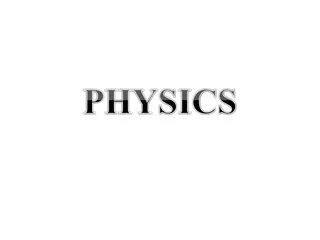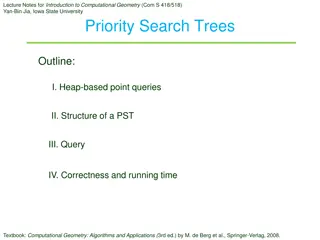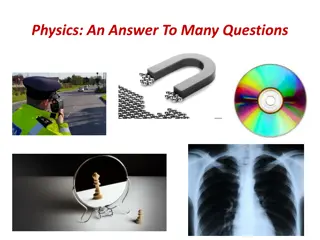Computational Physics (Lecture 18)
The basic structure of MPICH and its features in Computational Physics Lecture 18. Understand how MPI functions are used and linked with a static library provided by the software package. Explore how P4 offers functionality and supports parallel computer systems. Discover the concept of clusters in P4 and how shared memory is utilized for peak performance. Find out what is included and excluded in MPI, as well as the hello world program and compiling details.
Download Presentation

Please find below an Image/Link to download the presentation.
The content on the website is provided AS IS for your information and personal use only. It may not be sold, licensed, or shared on other websites without obtaining consent from the author.If you encounter any issues during the download, it is possible that the publisher has removed the file from their server.
You are allowed to download the files provided on this website for personal or commercial use, subject to the condition that they are used lawfully. All files are the property of their respective owners.
The content on the website is provided AS IS for your information and personal use only. It may not be sold, licensed, or shared on other websites without obtaining consent from the author.
E N D
Presentation Transcript
Computational Physics (Lecture 18) PHY4061
The basic structure of MPICH Each MPI application can be seen as a collection of concurrent processes. In order to use MPI functions, the application code is linked with a static library provide by the MPI software package. The library consists of two layers. The upper layer comprises all MPI functions that have been written hardware independent. The lower layer is the native communication subsystem on parallel machines or another message passing system, like PVM or P4.
P4 offers less functionality than MPI, but supports a wide variety of parallel computer systems. The MPI layer accesses the P4 layer through an abstract device interface. So all hardware dependencies will be kept out of the MPI layer and the user code.
Processes with identical codes running on the same machine are called clusters in P4 terminology. P4 clusters are not visible to an MPI application. In order to achieve peak performance, P4 uses shared memory for all processes in the same cluster. Special message passing interfaces are used for processes connected by such an interface. All processes have access to the socket interface. Standard for all UNIX machines.
What is included in MPI? Point to point communication Collective operations Process groups Communication contexts Process topologies Bindings for Fortran77 and C Environmental Management and inquiry Profiling interface.
What does the standard exclude? Explicit shared memory operations Support for task management Parallel I/O functions
MPI says hello world MPI is a complex system that comprises 129 functions. But a small subset of six functions is sufficient to solve a moderate range of problems! The hello world program uses this subset. Only a basic point-to-point communication is shown. The program uses the SPMD paradigm. Similar to SIMD All MPI processes run identical codes.
The details of compiling this program depend on the systems you have. MPI does not include a standard for how to start the MPI processes. Under MPICH, the best way to describe ones own parallel virtual machine is given by using a configuration file, called a process group file. On a heterogeneous network, which requires different executables, it is the only possible way. The process group file contains the machines (first entry), the number of processes to start (second entry) and the full path of the executable programs.
Example process group file hello.pg Sun_a 0 /home/jennifer/sun4/hello Sun_b 1 /home/jennifer/sun4/hello Ksr1 3 /home/jennifer/ksr/ksrhello Suppose we call the application hello, the process group file should be named hello.pg. To run the whole application it suffices to call hello on workstation sun_a, which serves as a console. A start-up procedure interprets the process group file and starts the specified processes. sun-_a > hello
The file above specifies five processes, one on both Sun workstations and three on a KSR1 virtual shared memory multiprocessor machine. By calling hello on the console (in this case, sun_a), one process group file contains as number of (additional) processes the entry zero to start on every workstation just one process.
This program demonstrates the most common method for writing MIMD programs. Different processes, running on different processors, can execute different program parts by branching within the program based on an identifier. In MPI, this identifier is called rank.
MPI framework The functions MPI_Init() and MPI_Finalize() build the framework around each MPI application. MPI_Init() must be called before any other MPI function may be used. After a program has finished its MPI specific part, the call of MPI_Finalize() take care for a tidy clean up. All pending MPI activities will be canceled.
Who am I, How many are we? MPI processes are represented by a rank. The function MPI_Comm_rank() returns this unique identifier, which simply is a nonnegative integer. (number of processes_1) To find out the total number of processes, MPI provides the function MPI_Comm_size(). Both MPI_Comm_rank() and MPI_Comm_size() use the prameter MPI_COMM_WORLD, which marks a determined process scope, called a communicator.
The communicator concept is one of the most important of MPI and distinguishes this standard from other message passing interfaces. Communicators provide a local name space for processes and a mechanism for encapsulating communication operations to build up various separate communication universes . That means a pending communication in one communicator never influences a data transfer in another communicator. The initial communicator MPI_COMM_WORLD contains all MPI processes started by the application.
In a transferred sense, it would be possible to consider a communicator as a cover around a group of processes. A communication operation always specifies a communicator. All processes involved in a communication operation have to be described by their representation on the top side of the cover (communicator rank).
There are some other MPI concepts such as virtual topologies and user defined attributes, which may be coupled to a communicator. MPI doesn t support a dynamic process concept. After start up MPI provides no mechanism to spawn new processes and integrate them into a running application.
Sending/Receiving Messages An MPI message consists of a data part and a message envelope. The data part is specified by the first three parameters of MPI_Send()/MPI_recv() which describe the location, size and datatypes which correspond to the basic data types of the supported languages. In the example, MPI_CHAR is used which matches with Char in C. The message envelope describes destination, tag and communicator of the message. The tag argument can be used to distinguish different types of messages.
By using tags, the receiver can select particular messages. In this example the master, which is process zero, sends his host name to all other processes, called slaves. The slaves receive this string by using MPI_Recv(). After communication is finished, all processes print their Hello World that appear on the MPI console (Host sun_a)
Running parallel jobs on clusters * This is a 45-nodes cluster formed by DELL R720/R620 servers. * It is divided into 2 sub-clusters (zone0 & zone1) * Zone0 contains 20 nodes (z0-0...z0-19) interconnected by Infiniband (QDR) * Zone1 contains 25 nodes (z1-0...z1-24) interconnected by Infiniband (QDR) * Memory installed : 32GB on 40nodes (z0-0~z1-19), 64GB on 4nodes (z1-20~23), 96GB on 1node (z1-24) * Head Node: cluster.phy.cuhk.edu.hk (137.189.40.13) * Storage Node : 60TB (User's disk quota: /home/user/$user 500MB, /home/scratch/$user 500GB) * Use department computer account ID and Password to logon * Home directory/Disk Quota are independent from other dept. workstations * OS : Rocks 6.1 (CentOS) * MPI : MVAPICH2 2.0a (mpirun_rsh mpirun mpiexec) * Compilers : mpicc mpicxx mpic++ mpif77 mpif90 * Queueing : TORQUE + MAUI (qsub qstat qhold qrls qdel) * hostfile : $PBS_NODEFILE
Hostname Remarks ---------------------------------------------------------------------- cluster Head Node, DELL R720, 64G_RAM nas Storage Node, DELL R720, 64G_RAM, 60TB_Storage z0-0 ... z0-19 Zone0 Compute Nodes (20 nodes), 32G_RAM, Queue: zone0 z1-0 ... z1-19 Zone1 Compute Nodes (20 nodes), 32G_RAM, Queue: zone1 z1-20 .. z1-23 Zone1 Compute Nodes (4 nodes), 64G_RAM, Queue: zone1, bigmem z1-24 Zone1 Copmute Nodes (1 node), 96G_RAM, Queue: zone1, bigmem ---------------------------------------------------------------------- ** All nodes equipped Two Intel Xeon E5-2670 2.6GHz 8-Core (2 threads per core) CPUs (i.e. 32 threads per node)
Quick User Guide ================ * SSH Login cluster.phy.cuhk.edu.hk or 137.189.40.13 using your dept. account * Compile your MPI source code using : mpicxx mpicc mpic++ mpif77 mpif90 * Create a Job Script * Submit your program to queue by "qsub" Example : =================================================================== ========================= cluster > mpicc -o myjob myjob.c ## Compile your program first Create a job script for queueing, say "myjob.sh", like below :
#!/bin/bash #PBS -S /bin/bash ## many Torque PBS directives can be found on internet #PBS -o myjob.out ## (optional) std. output to myjob.out #PBS -e myjob.err ## (optional) std. error to myjob.err #PBS -l walltime=01:00:00 ## request max. 1 hour for running #PBS -l nodes=2:ppn=32 ## run on 2 nodes and 32 processes per node #PBS -q zone1 ## (optional) queue can be zone0,zone1(default),bigmem cd $PBS_O_WORKDIR ## change to current directory first echo "Start at `date`" ## (optional) count the time used cat $PBS_NODEFILE ## (optional) list the nodes used for this job mpirun -hostfile $PBS_NODEFILE ./myjob ## run myjob on 2 nodes * 16 proc/node echo "End at `date`" ## (optional) found in myjob.out -------------------------------------------------------------------------------------------- cluster > qsub myjob.sh ## Submit myjob into default queue 88.cluster.local ## Job id in the queue cluster > qstat cluster > qstat -Q ## check how many jobs Run/Queued by all users ## check all MY jobs status, show details : qstat -f job_id cluster > qdel 88 ## use qhold/qrls/qdel to hold/release/delete job
Remarks : 1. Determine which queue you use (default is zone1), 2. Nodes used cannot exceed the total number of available nodes (i.e. You can't set ppn > 32, and if you use queue bigmem, you can't set nodes > 5) 3. ALL jobs submitted to nodes manually but not via "qsub" WILL BE KILLED automatically ****
Density functional theory: foundations DFT is a theory of correlated many-body systems. In close association with independent-particle methods, Because it has provided the key step that has made possible development of practical, useful independent-particle approaches Incorporate effects of interactions and correlations among the particles.
DFT has become the primary tool for calculation of electronic structure in condensed matter Increasingly important for quantitative studies of molecules and other finite systems. Remarkable successes of the approximate local density and generalized-gradient approximation functionals within the Kohn-Sham approach Led to wide spread interest in DFT as the most promising approach for accurate, practical methods in the theory of materials.
History The modern formulation of DFT: Originated in a famous paper written by P. Hohenberg and W. Kohn in 1964. A special role can be assigned to the density of particles in the ground state of a quantum many- body system: the density can be considered as a basic variable. All properties of the system can be considered to be unique functionals of the ground state density
In 1965, Mermin extended the Hohenberg-Kohn arguments to finite temperature canonical and grand canonical ensembles. The finite temperature extension hasn t been widely used Generality of DFT and the difficulty of realizing the promise of exact DFT. So there could be chances for future development. In 1965, A classic work by W. Kohn and L. J. Sham, whose formulation of DFT has become the basis of much of present day methods for treating electrons ion atoms, molecules and condensed matter.
Thomas-Fermi-Dirac approximation: example of a functional Thomas and Fermi proposed in 1927 The original density functional theory of quantum systems. Their approximation is not accurate enough for present day electronic structure calculations. The approach illustrates the way density functional theory works.
In the original Thomas Fermi method, the kinetic energy term is approximated as an explicit functional of the density, idealized as non-interacting electrons in a homogeneous gas with density equal to the local density at any given point. Exchange and correlation are neglected. In 1930, Dirac extended the theory. Formulated the local approximation for exchange. Still in use today!
An energy functional for electrons in an external potential Vext(r) ???[n]=?1 ?3??(?)5/3+ ?3? ????? ? ? + ?2 ?3? ? ?4/3 + ?3? ?3? ? ? ? (?)/|? ? | The first term is the local approximation to the kinetic energy, with C1 = 3/10 (3 2)(2/3)=2.871 in atomic units. The third term is the local exchange with C2 = -3/4(3/ )(1/3)for the case of equal up and down spins and the last term is the classical electrostatic Hartree energy.
The ground state density and energy can be found by minimizing the functional E[n] for all possible n(r)subject to the constrain on the total number of electrons: ?3r n(r)=N. Using the Lagrange multipliers, the solution can be found by an unconstrained minimization of the functional ??[n] = E??[n] { ?3r n(r) N} Where the Lagrange multiplier is the Fermi energy.
For small variations of the density n(r), the condition for a stationary point is: ?3r{ ??[n(r)+ n(r)]- ??[n(r]} -> ?3r{5 Where V(r) = Vext(r)+ Vhartree(r)+Vx(r) is the total potential. The above equation has to satisfy any function n(r) it follows that the functional is stationary if and only if the density and potential satisfy the relation: (3 2)(2/3)n(r)2/3+V(r)- =0. 3?1n(n)2/3+V(r)- } n(r)=0
Extensions to account for effects of inhomogeneity have been proposed by many people. For example by Weizsacker correction: (?n (r))2/n (r). Recent correction was found to be 1/36(?n (r))2/n (r).
The attraction of density functional theory is evident by the fact that one equation for the density is remarkably simpler than the full many body Schrodinger equation that involves 3N degrees of freedom for N electrons. However, this approach starts with approximation that are too crude, missing essential physics and chemistry, such as shell structures of atoms and binding of molecules. Thus it falls short of the goal of a useful description of electrons in matter!























